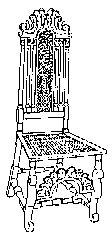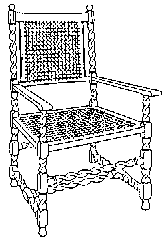Restoration Furniture – English Period Furniture
Restoration Furniture 1660-1688
Restoration Furniture style was at the time of the return of the court from its ten-year exile. It brought about an extreme reaction.
Charles 11 Chair c. 1685, cresting rail fixed on top of chair back. Now back in England, Charles II and his court surrounded themselves with furniture resembling the most lavish they had seen in France and Holland.
This caused an immediate reaction to the stifling restrictions of the Puritans.
The upper classes took their cue from the court with much extravagant furniture, and gradually the middle class followed.
It was an excessively civilized society, and great ladies rivaled each other in the grandness of their dressing rooms, which created a new demand for items of furniture.
![]()
Flemish S Scroll leg
The bureau, the bookcase and the Day Bed made their first appearance.
The great fire of London was in 1666, and the city had to be rebuilt, smaller rooms were created.

Restoration Furniture – Charles 11 Chair c. 1685, cresting rail fixed on top of chair back.

Restoration Furniture – Early Cane Chair c. 1665 with barley sugar or corkscrew turning.
Restoration Furniture Period Features
- Walnut veneer replaced solid oak timber.
- Chair frames were sometimes guilded or silvered.
- Upholstery and silk fringes became fashionable.
- The wing chair was introduced, upholstered stools and benches in elaborate design were popular.
- The first bookcase made an appearance. Books were previously kept in a chest or cupboard.
- Visible Drawers.
- Wardrobes were used to hold rich and varied clothes.
- The Flemish S scroll.
- Octagonal shaped panels.
- Barley-sugar or corkscrew twist turning. “X” shaped curved stretcher rails.
- Cresting rail fixed on top of chair back. Tall chair backs with weight saving split cane.
- Smaller gate leg tables with twist turning.
- Craftsman were brought in from France to teach new skills with refinement in construction, carved work and the newer inlaid craft.
- Inlaid solid timber in recesses, parquetry – geometrical patterns of solid timber.
- Marquetry using veneer was not yet used.
Restoration Furniture
More information on Styles and Periods of Interior Decorating
Styles and Periods
Furniture History
Decorating Styles
Period Decoration
What is Style?
